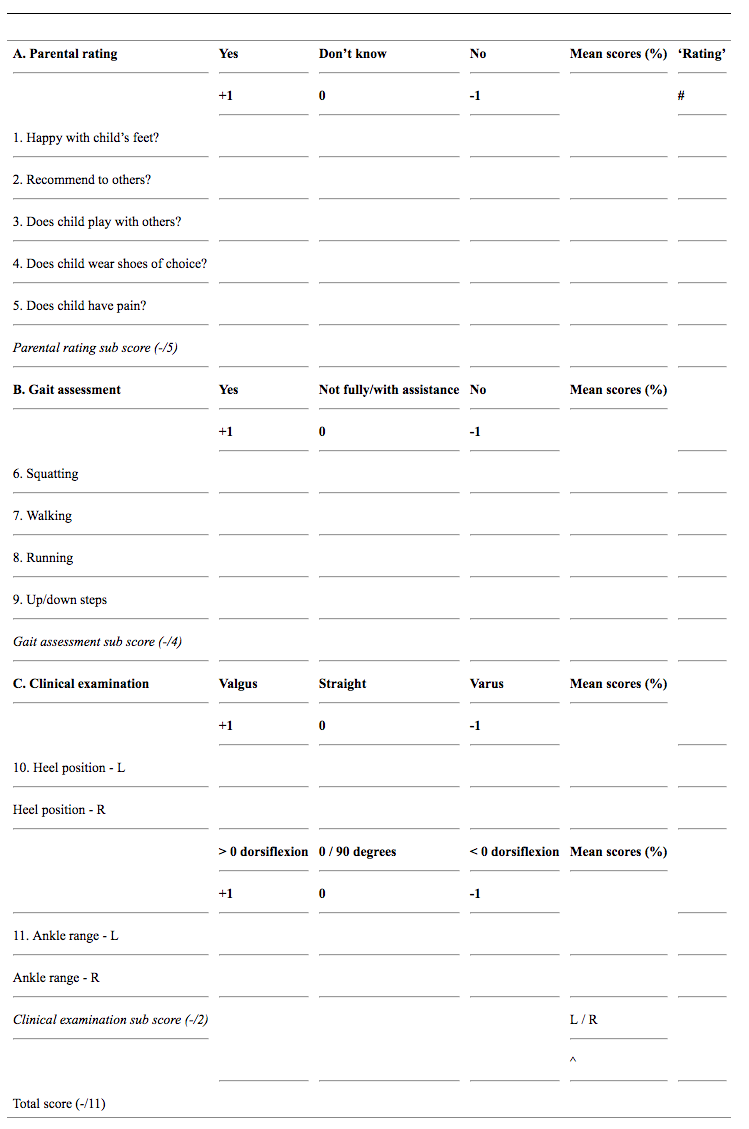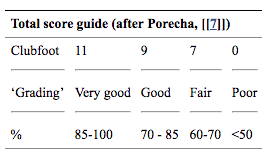Bangla Clubfoot Tool
Original Editor - Rachael Lowe
Top Contributors - Kim Jackson, Rachael Lowe, Simisola Ajeyalemi, Rucha Gadgil, Meaghan Rieke and Olajumoke Ogunleye
Objective[edit | edit source]
The Bangla clubfoot tool [1] was developed to suit the context of the large Walk For Life clubfoot program in Bangladesh. It was largely developed from components of existing validated clubfoot assessment measures (such as the Roye Score), and adapted for local use. It is accurate, expedient, and inexpensive and has been shown to be a very reliable evaluation instrument[1].
Intended Population[edit | edit source]
This tool is used to assess outcomes for children with clubfoot in Bangladesh and may be a suitable measure to use across other lower and middle income settings. It is designed for use in busy clinics to assess results of clubfoot management in children of walking age, ie mid-term to longer-term results[1].
Method of Use[edit | edit source]
Three areas of examination are included: parent satisfaction, gait, clinical examination of the clubfoot[1]. The subjective elements of parents’ assessment addressed satisfaction with their child’s treatment (five questions). The gait and clinical aspects of assessment included the children’s physical ability to squat, walk, run, and use stairs, (four items) and objective assessment of heel position and ankle range (two items)[2].
The scoring system provides easily understood categories.
Reference[edit | edit source]
Evans AM, Perveen R, Ford-Powell VA, Barker S. The Bangla clubfoot tool: a repeatability study. Journal of foot and ankle research. 2014 May 6;7(1):27.
Evidence[edit | edit source]
Evans et al[1] demonstrated this simple tool to feature good reliability both within and between examiners. A more recent study by Smythe et al, in 2018, comparing outcome measures after the Ponsetti method had good inter-observer agreement between the two expert physiotherapists. The study found that Bangla score had a sensitivity of 79.2% (95%CI: 57.8-92.9%) and a specificity of 79.5% (95%CI: 64.7-90.2%) in predicting the need for referral with positive and negative predictive values of 67.9% and 87.5% respectively[3]
References[edit | edit source]
- ↑ 1.0 1.1 1.2 1.3 1.4 Evans AM, Perveen R, Ford-Powell VA, Barker S. The Bangla clubfoot tool: a repeatability study. Journal of foot and ankle research. 2014 May 6;7(1):27.
- ↑ Evans AM, Chowdhury MM, Kabir MH, Rahman MF. Walk for life-the National Clubfoot Project of Bangladesh: the four-year outcomes of 150 congenital clubfoot cases following Ponseti method. Journal of foot and ankle research. 2016 Nov 9;9(1):42.
- ↑ Smythe T, Gova M, Muzanuwi R, Foster A, Lavy C. A Comparison of outcome measures used to report clubfoot treatment with the Ponseti method: results from a cohort in Harare, Zimbabwe. BMC Musculoskeletal Disorders (2018) 19:450








